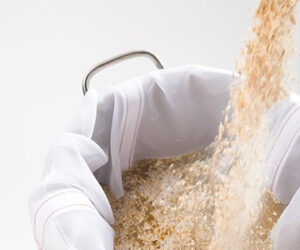Beating Summer’s Heat

It’s a task I try to avoid as best I can . . . brewing on a hot summer day. I don’t deal well with heat and the addition of big boiling pots and all the steam that gets released doesn’t help my cause. Add to that the fact that fermentation temperatures can be hard to control during heat spells without dedicated temperature control equipment and it’s easy to see why I used to take summers off from the hobby. But things have changed and even without a heavy investment in space and equipment, homebrewers can navigate through even some of summer’s warmest spells.
Brew Day Tricks
The first piece of advice is the most obvious to anyone that has to cope with intense summer heat on a regular basis . . . early mornings are the coolest part of the day. Setting your alarm to get going at the crack of dawn can assure you that things are wrapping up before the intense heat of the day gets going. Now if you live in a humid environment, you may find that mornings are coolest, but humidity levels can often be near 100% at that time. Evenings you may find to be quite a bit warmer, but humidity levels can be significantly lower. A misting spray bottle on hand will find more efficacy during the less humid times.
If you have air conditioning, brewing indoors can certainly be a nice relief from the heat. The rise of electric systems has made this a simple and safe solution for many homebrewers in hot climates, but unfortunately sending all that vapor into your air can really stress your HVAC unit. There are two solutions, but both require an investment. Many indoor brewers will add a good ventilation system to collect the steam from the brew kettle and send it outside. This can still stress your HVAC system as any air vented out will be replaced with hot air from outside . . . but it’s still better than steam. Another system is a condensation unit where a cool mist is sprayed into steam and the cool water is enough to knock the steam out of vapor phase and back into liquid mode. To find plans, visit: https://byo.com/project/homebrew-steam-condenser/
If you’re into sour beers, no-boil, quick sours are not only perfect thirst-quenching drinks for the summer, but the fact that you don’t need to boil the wort can save a lot of sweat. A simple pasteurization step means bringing the wort to 175 °F (80 °C) for 15 to 20 minutes can kill most all troublesome microbes that could be lurking. For more on this style of brewing, check out: https://byo.com/mr-wizard/57426/
Chilling Problems
For folks in warmer climates, the temperature of your chilling water may be a problem when trying to get wort down from boiling to standard fermentation temperatures. There are many workarounds available and nothing can be more helpful than patience. Australia is well-known for their no-chill approach to cooling their wort and it’s perfect for those that live in a region where water is scarce since it uses no water. In this process, the hot wort is placed into a sterile, heat-tolerant container and allowed to cool overnight. Aussie’s typically use a HDPE “hedpack” container to store the wort while it cools. A stainless container could also be used. Glass or PET plastic vessels should not be used for this process. The yeast is then pitched once wort has sufficiently cooled. A refrigerator can be utilized if further cooling is needed.
Ice can also be used if your tap water is too warm to chill all the way down to yeast-pitching temperature. Some homebrewers will utilize a two-stage chilling process if using a counterflow system, but others that utilize either an immersion chiller or counterflow system will switch from tap water to ice water bath for the final step down to yeast-pitch temperature.
No matter what, patience should be used to make sure that the wort is not too warm when yeast is pitched as brewers will want the wort to be within recommended temperature range within 12 hours after pitching to avoid off-flavors.
Beast Yeast
As mentioned in the introduction, fermentation temperature control can be a challenge. When the recommended temperature range of many lager and ale yeast strains is exceeded, the yeast can start to produce off-flavors, such as fusel alcohols that can make the beer taste “hot,” as well as excess esters. Luckily, we now have a whole world of yeast strains available that can handle temperatures that far exceed standard room temperature of roughly 68 °F (20 °C).
Just how warm your fermentation space is can dictate what strains specifically should be used. If the space is generally in the lower 70s °F (low 20s °C), then a forgiving ale strain like the Chico strain can be used. Past that and you’ll want to look at Belgian and other farmhouse ale strains like saison yeast, some of which can handle temperatures well into the 90s °F (low 30s °C). Another family of yeast that can easily handle temperatures like this are kveik strains, which, unlike most Belgian strains, are POF- (phenolic off-flavor negative) meaning they can produce fairly clean beer. A whole range of styles can be brewed with kveik yeast including lager-like beers, IPAs, and stouts.


